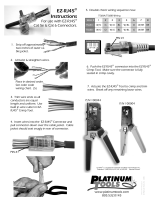Connected Test
When LEDs for Connected, S, and 1...8 LED are on and the tester beeps three times, it
means the shielding and indicated wires are pin-to-pin connected between cable’s two
ends. For instance, if a standard Ethernet 10BaseT unshielded twisted-paired cable (UTP)
are tested, the LEDs for Connected, Wire 1, 2, 3 and 6 will turn on.
Note: If there is only one wire connected inside a cable between the cable’s two ends, the
tester will state no wire connected.
Connected and Non-parallel Test
LEDs for both Connected and Non-parallel, and LEDs for Wire S, 1, 2, ...8 turn on and
the tester beeps twice, it means the shielding and indicated wires are connected between
cable’s two ends, but not pin-to-pin straight connection. It is possibly a wrong connection
cable or a cross-over cable.
Note: If there are only two wires connected inside a cable between the cable’s two ends,
the tester cannot detect whether these two wires are pin-to-pin connected or not. It only
indicates two wires connected.
No Connection Test
When the No Connection LED turns on and the tester beeps once, it means there is no
connection between the master and the remote module. It happens when no cable is
connected with the tester.
Testing BNC Connector
LED for Short, S and C
When LEDs for Short, S and C, turn on and the tester beeps four times, it means the
shield and the center of the BNC connector is short.
LED for 25 OHM, S and C
When the LEDs for the 25 OHM, S and C turn on and the tester beeps three times, it
means the tested cable it terminated with correct terminated resister value.
LED for 50 OHM, S and C
When the LEDs for 50 OHM, S and C turn on and the tester beeps twice, it means a
single ending terminated resister value is detected. It may be caused by a broken cable,
or the terminator at one end is not linked well.
LED for No Terminator
When the LED for No Terminator turns on and the tester beeps once, it means no resister
value detected between shielding and center. The cable is probably not terminated
(all open).
3













